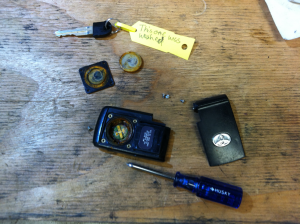Here’s a Prius II key fob disassembled after having gone through the wash.
This fob isn’t worthless. You can still use the key in the driver’s door key cylinder. (I’m not sure if there is a passenger door key cylinder…) And the passive transponder still works to start the car as long as the fob is put into the slot. But I don’t think there’s any chance of the remote functions and SmartKey capability being brought back to life– much cheaper and more reliable to get a new one.
(BTW, you can tell that this is a SmartKey because of the silver Toyota logo. For non-SmartKey Prii, the logo is just embossed in black.)
